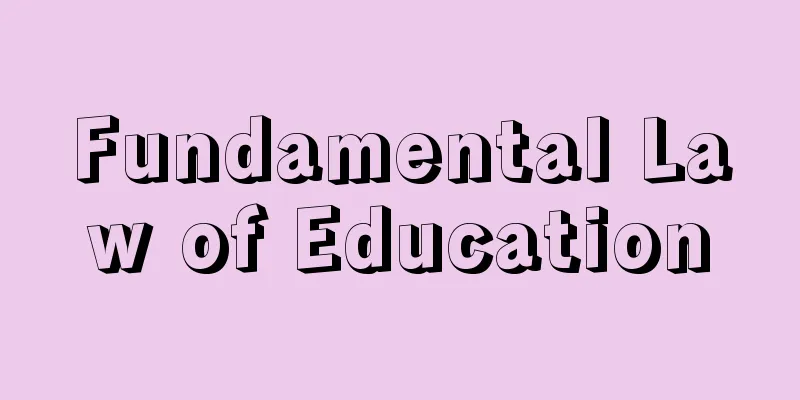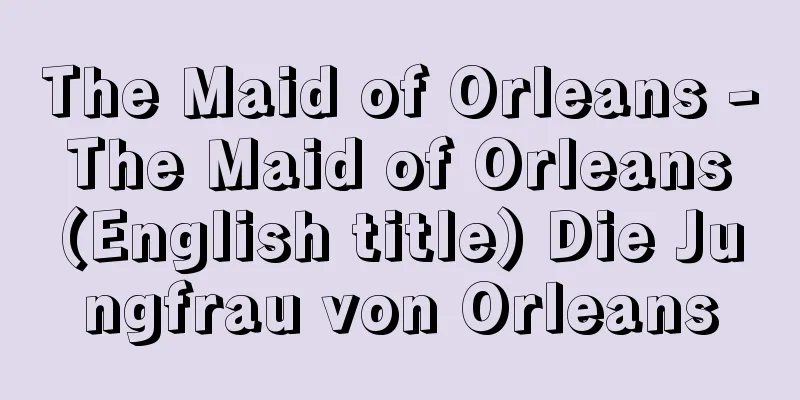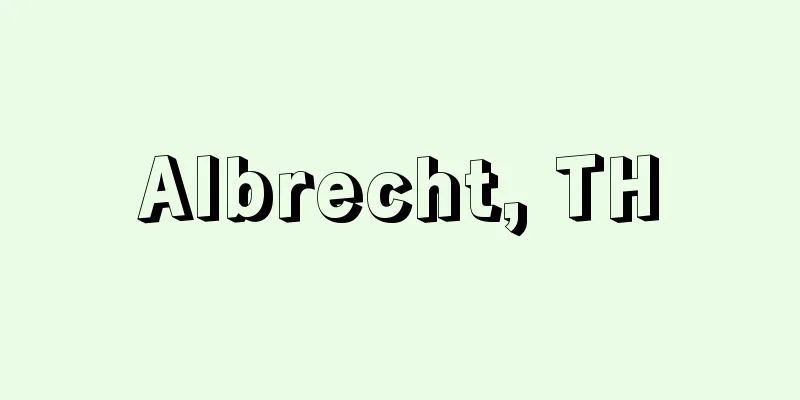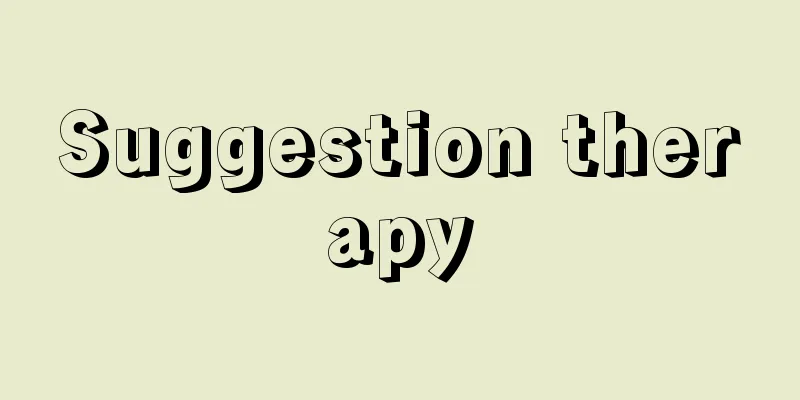Fundamental Law of Education

|
This law, Act No. 25 of 1947, directly proclaims the basic philosophy on education and the basic principles of the education system (which were required in relation to the shift from imperial decree-based to legal-based education regulations) that were expected to be stipulated in the Constitution of Japan. Unlike the Constitution, it does not have the power to invalidate other legal provisions that contradict this law. However, it is generally considered that the interpretation and application of education-related laws should be in accordance with the provisions, intent, and purpose of this law. [Kimura Tsuneo] PersonalityIn this regard, the following can be said: (1) The core of the basic philosophy of education that replaces the Imperial Rescript on Education is the widespread dissemination of education that respects the dignity of the individual, aims to perfect the personality, aims to cultivate people who seek truth, peace, and justice, and aims to create a universal and unique culture. The preamble and Article 1 of the law declare that overcoming the problems that public education faced before the Second World War, realizing the ideals of democratic politics set forth in the Constitution, and even contributing to world peace and the welfare of mankind, are all dependent on the power of education guided by these ideals. Furthermore, Article 2 emphasizes academic freedom, practical life, a voluntary spirit, respect for oneself and others, and cooperation, and so on. It can be said that the ideals were confirmed through questioning the educational meaning of civil liberties, among the fundamental human rights enumerated in the Constitution as the result of mankind's efforts over many years to obtain freedom. (2) The provisions of Article 3 on equal opportunity in education, Article 4 on compulsory education, and Article 5 on coeducational education, on the other hand, are a reaffirmation of the Constitution's idea of equal rights in the educational field, and, together with Article 26 of the Constitution, declare a fundamental review of prewar public education, which developed on the basis of the idea of one emperor and all people, or the Emperor's concept of equality as children. Historically, the ideals of freedom and equality have sometimes reinforced each other, but at other times clashed. The principle of equal opportunity in education, together with the following principles, can be said to play the role of a link between freedom and equality, which sometimes clash. (3) The provisions of Article 6 on school education and Article 7 on social education can be seen as having been established to systematically separate the two, based on the fact that the "public nature" of education differs depending on the place where it is conducted, and to ensure that school education, which has a high degree of publicness, and social education, which values autonomy and spontaneity, complement each other. This is a natural consequence of the Act, which states in Article 2 that the purpose of education should be realized at every opportunity and in every place. The public nature of education is maintained by a desire for equality, which is difficult to achieve without the intervention of public authority, and freedom there is naturally restricted. This principle of division of educational settings and mutual complementarity will be the most important principle for resolving various problems that arise in the future as we move forward with the institutionalization of lifelong learning and education. (4) The provisions of Article 8 on political education and Article 9 on religious education set out the principle of neutrality in school education, which is highly public in nature. Political education related to a specific political party is prohibited in all schools as specified by law, and sectarian religious education is prohibited in national and public schools. Cultivating the ability to make value judgments about political power and religious authority is a fundamental premise of civil liberty. However, this always clashes with the principle of equality that makes public education public. The principle of neutrality can be said to be an attempt to overcome the conflict between freedom and equality by complementing school education with out-of-school education. (5) Article 10 of the Educational Administration also states that education must not be subject to undue control, and that educational administration should be carried out with the aim of establishing and improving the conditions for education. As we have seen, the principle of establishing the conditions that make education education is deeply connected to freedom, and the principle that makes education public education is deeply connected to the principle of equality. The former corresponds to guidance and advice administration, and the latter corresponds to supervisory administration. The law can be read as wishing to overcome the clash between freedom and equality in the field of education, and to have educational administration turn public education into public education, in conjunction with the enhancement of private education, which will ultimately become the force that turns political power into public power, and as such, ordering this on behalf of the Constitution. It is also important to note that the supplementary provisions of Article 11 stipulate that appropriate legislation shall be enacted to implement this law. [Kimura Tsuneo] New Fundamental Law of EducationOn December 22, 2006, the new Fundamental Law of Education was promulgated and put into effect (Law No. 120 of 2006). The new Fundamental Law of Education, taking into account the changes in the educational situation since the old law was enacted (1947), stipulates the objectives and philosophy of education from a contemporary perspective, as well as the basic principles for the implementation of education. With regard to educational administration, new provisions have been added regarding the division of roles and financial measures between the national and local governments, and a new article has been added stipulating the formulation of a basic plan for the promotion of education. [Editorial Department] "Commentary on the Fundamental Law of Education" edited by the Ministry of Education Educational Legislation Study Group (1947, Kunitachi Shoin) " ▽ "Fundamental Law of Education" edited by Munakata Seiya (1966, Hyoronsha)" ▽ "Educational Administration" by Suzuki Eiichi (Postwar Japanese Educational Reform, Vol. 3, 1970, University of Tokyo Press)" ▽ "Establishment of the Fundamental Law of Education" by Sugihara Seishiro (1983, Nippon Hyoronsha) [Reference items] | | |Source: Shogakukan Encyclopedia Nipponica About Encyclopedia Nipponica Information | Legend |
|
直接、憲法に定められるべく期待されていた教育に関しての基本理念と、そして教育制度の基本原則(教育法規の勅令主義から法律主義への転換とのかかわりで求められた)とを、日本国憲法にかわり宣明した法律。昭和22年法律第25号。憲法のように同法と矛盾する他の法律規定を無効にする力はない。しかし一般に教育関係法令の解釈および運用については、同法の規定、趣旨、目的に沿うよう配慮すべきであるとされている。 [木村力雄] 性格それについては、次のことがいえる。 (1)教育勅語にかわる教育の基本理念の核は、個人の尊厳を重んじ、人格の完成を目ざし、真理、平和、正義を希求する人間の育成を期し、普遍的で個性豊かな文化の創造を目ざす教育の普及徹底ということにある。第二次世界大戦前の公教育の抱えていた課題の克服も、憲法の掲げる民主政治の理想の実現も、さらには世界平和や人類の福祉への貢献も、以上のような理念に導かれた教育の力にまつべきことが、同法の前文、第1条で宣明されている。また第2条で、学問の自由、実際生活、自発的精神、自他の敬愛と協力などが強調されているところから、その理念は、憲法に人類の多年にわたる自由獲得の努力の成果として列記された基本的人権のうち、とくに市民的自由の教育的意味を問うことを通じて確認されたものといえる。 (2)第3条教育の機会均等、第4条義務教育、第5条男女共学の諸規定は、それに対し、憲法の平等権思想の教育面における再確認で、憲法第26条とともに、一君万民あるいは天皇の赤子的平等観に支えられ発達をみた戦前の公教育を、根底から見直すよう宣明している。歴史的にみて自由と平等の理念は、ときに補強し合いながら、ときにぶつかり合ってきた。教育の機会均等の原則は、以下の諸原則とともに、ときにぶつかり合う自由と平等の結び目の役割を果たしているともいえよう。 (3)第6条学校教育と第7条社会教育の規定は、教育の行われる場所によって、その「公の性質」に差の生じることを踏まえ、両者を制度的に分け、公共性の高い学校教育と、自主性・自発性の重んじられる社会教育とが、相互に補完し合うよう設けられたものとみることができる。教育の目的は、あらゆる機会にあらゆる場所で実現されるべきである(2条)とする、同法の当然の帰結といえよう。 教育における公共性は平等への意志により保たれ、公権力の介入なしにその実現は困難であり、そこでの自由は当然制限される。この教育の場の区分と相互補完の原則は、今後、生涯学習、生涯教育の制度化を進めるうえで生じる諸問題を解決していくためにももっとも重要な原則となろう。 (4)第8条政治教育、第9条宗教教育の規定は、公共性の高い学校教育における中立性の原則を示したもので、特定の政党にかかわる政治教育は法律の定めるすべての学校で禁止され、宗派宗教教育は国・公立学校で禁止されている。政治権力や宗教的権威に対する価値判断能力の育成は、市民的自由の大前提である。しかしそれは、公教育を公教育たらしめている平等の原則とつねにぶつかる。中立性の原則は、自由と平等の相克を学校教育と学校外教育との補完によって、超えようとしたものといえよう。 (5)第10条教育行政には、教育は不当な支配に服してはならないこと、教育行政は諸条件の整備確立を目ざして行われるべきことが併記されている。これまでみてきたところからも、教育を教育たらしめる条件整備の原則は、自由と深くかかわり、また教育を公教育たらしめる原則は、平等の原則と深くかかわっている。前者は指導助言行政と、後者は監督行政とそれぞれ対応する。 自由と平等の教育の場面でのぶつかり合いを超えて、私教育の充実と相まって、教育行政が公教育を公教育たらしめ、それが結果として、政治権力を公権力たらしめる力となることをこそ同法は願い、憲法にかわって、このように命じたものと読める。第11条補則に、この法律の実施のため、適当な法令の制定さるべきことが定められていることも見落とせない。 [木村力雄] 新しい教育基本法2006年(平成18)12月22日に新しい教育基本法が公布・施行された(平成18年法律第120号)。新教育基本法は、旧法制定(1947)後の教育を巡る状況の変化をふまえて、今日的な視点での教育の目的及び理念、教育の実施に関する基本を定めている。教育行政に関しては、国と地方公共団体の役割分担や財政上の措置について新たに規定し、教育振興基本計画を策定することも新条を設けて規定している。 [編集部] 『文部省内教育法令研究会編『教育基本法の解説』(1947・国立書院)』▽『宗像誠也編『教育基本法』(1966・評論社)』▽『鈴木英一著『教育行政』(『戦後日本の教育改革 第3巻』1970・東京大学出版会)』▽『杉原誠四郎著『教育基本法の成立』(1983・日本評論社)』 [参照項目] | | |出典 小学館 日本大百科全書(ニッポニカ)日本大百科全書(ニッポニカ)について 情報 | 凡例 |
<<: Educational Administration
>>: Educational equipment - Educational equipment
Recommend
Chlorite (English spelling)
A general term for chlorite minerals, also called...
Joual - Joual (English spelling) parler joual
A dialect of French. It is the language that devel...
Compensation - Aikyu
A form of chigyo (landholding) in the Edo period....
Solenodon - That's it (English spelling) solenodon
A primitive insectivore resembling a large shrew. ...
khaki
...A brownish-brown color, it was the first prote...
Ward Head Association - kukochokai
...the general term for prefectural assemblies, l...
Ragha
…A city in central Iran. Its ancient name was Rag...
Stone masonry - Ishitsumi
(Also called "Ishizumi") 1. The construc...
World Federation of Trade Unions
…World Federation of Trade Unions (WFTU) is an ab...
Wind tunnel - fuudou (English spelling) wind tunnel
A device that artificially creates a uniform air ...
Josetsu - Josetsu
Years of birth and death unknown. A painter-monk ...
Honcho Hoke Genki - The Tale of the Lotus Sutra
A collection of Buddhist tales from the mid-Heian...
Sea of Okhotsk - Okhotsk Sea (English spelling)
A marginal sea in the northwest Pacific Ocean, se...
industrialism
…These ideas can be collectively called “early in...
Wolverine (crowing raccoon) - Wolverine (English spelling)
A carnivorous mammal of the Mustelidae family (ill...









